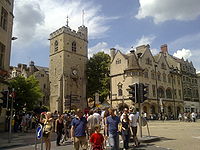
St Scholastica riot
Encyclopedia

Oxford
The city of Oxford is the county town of Oxfordshire, England. The city, made prominent by its medieval university, has a population of just under 165,000, with 153,900 living within the district boundary. It lies about 50 miles north-west of London. The rivers Cherwell and Thames run through...
.
The seed of the riot was an altercation in the Swindlestock Tavern (now the site of the Santander Bank on Carfax
Carfax, Oxford
Carfax is located at the conjunction of St Aldate's , Cornmarket Street , Queen Street and the High Street in Oxford, England. It is considered to be the centre of the city, and is at...
) between two students of the University of Oxford
University of Oxford
The University of Oxford is a university located in Oxford, United Kingdom. It is the second-oldest surviving university in the world and the oldest in the English-speaking world. Although its exact date of foundation is unclear, there is evidence of teaching as far back as 1096...
, Walter Spryngeheuse and Roger de Chesterfield, and the taverner, John Croidon. They complained about the quality of drinks, which led to an exchange of rude words that ended with the students throwing their drinks at the taverner's face and beating him up. Retaliation for this incident led to armed clashes between locals and students
Town and gown
Town and gown are two distinct communities of a university town; "town" being the non-academic population and "gown" metonymically being the university community, especially in ancient seats of learning such as Oxford, Cambridge, Durham and St Andrews, although the term is also used to describe...
. The mayor of Oxford, John de Bereford, asked the chancellor of the university, John Charlton, to arrest these two students, to no avail. Instead, two hundred students supported Spryngeheuse and Chesterfield, who allegedly assaulted the mayor and others. A riot broke out and lasted the following two days, which left 63 scholars and perhaps 30 locals dead. The scholars were eventually routed.
The dispute was eventually settled in favour of the university, when a special charter was created. Annually thereafter, on February 10th, the town mayor and councillors had to march bareheaded through the streets and pay to the university a fine of one penny for every scholar killed, a total of 5 s.
Shilling
The shilling is a unit of currency used in some current and former British Commonwealth countries. The word shilling comes from scilling, an accounting term that dates back to Anglo-Saxon times where it was deemed to be the value of a cow in Kent or a sheep elsewhere. The word is thought to derive...
3 d.. The penance ended 470 years later, in 1825 when the mayor of the time refused to take part.
It was not until six hundred years had passed that the hatchet was finally and formally buried when, on 10th February 1955, at a commemoration of the events of 1355, the Mayor was given an honorary degree and the Vice-Chancellor was made an Honorary Freeman.
See also
- St ScholasticaScholasticaScholastica is a saint of the Eastern Orthodox Churches and the Roman Catholic Church. Born in Italy, she was the twin sister of St. Benedict of Nursia....
, on whose feast day the riot occurred. - Town and GownTown and gownTown and gown are two distinct communities of a university town; "town" being the non-academic population and "gown" metonymically being the university community, especially in ancient seats of learning such as Oxford, Cambridge, Durham and St Andrews, although the term is also used to describe...
, term used to describe the parties in such conflicts.

